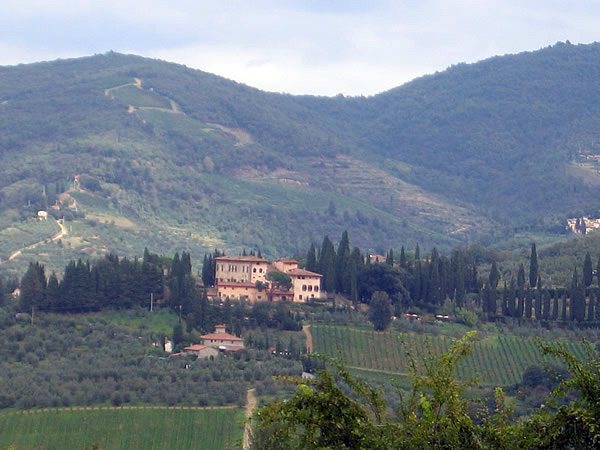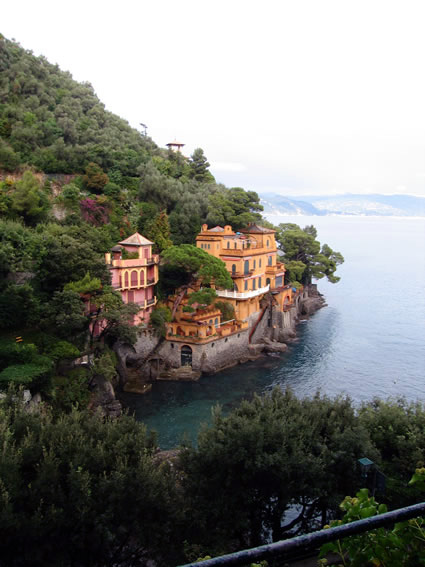Overland Travel in Europe
Explore the Diverse, Affordable, and Flexible Options
By Volker Poelzl
Resources updated 1/17/2024 by Transitions Abroad

|
|
Viewing Tuscan vineyards and olive groves while drively slowly through the magical landscapes is one of the most relaxing forms of travel. Photo © Transitions Abroad.
|
On a continent dotted with picturesque medieval and Renaissance towns amid spectacular landscapes, why would anyone choose to fly unless they were in a hurry? (Well, yes, cheap airfare in Europe is now common, but that is another discussion.) No matter the direction you cross Europe, watching the ancient world and landscapes fly by from your window seat in a train, bus, or car is a visual experience that every traveler should take advantage of. We will provide helpful information about traveling on the ground in Europe based upon our experience growing up and traveling there, then returning as much as possible.
Traveling in Europe by Train
Train travel is one of the most comfortable and pleasant ways to explore Europe. People of all ages and economic backgrounds travel by train. Sharing a conversation, meal, or drink with other passengers during the ride can be fun, watching the scenery pass by on the many smooth, modern, and often high-speed trains. In addition, trains usually take you straight to the city center, where most travelers prefer to stay. When planning your train itinerary, remember that many international airlines fly to several European destinations and may have sharing agreements with European airlines, allowing you to arrive in one country and fly out from another without additional cost. This can eliminate a train ride back to your arrival city, and you will be able to plan a one-way train itinerary, saving you both time and money.
Unfortunately, individual train tickets are pretty expensive, especially in Western Europe. Before buying a ticket or rail pass, consider your options carefully. It is best to plan your itinerary and determine how many days of rail travel you need to reach your destinations. Once, Eurail passes were the cheapest way to travel and were relatively unrestricted. Recently, prices have increased, and you must look out for hidden charges for reservations in certain countries, so please consider that as you plan.
Many different rail pass packages are available for Europe, and you should carefully research your options before purchasing your ticket. You can get a Eurail pass for all 33 participating countries, a multi-country rail pass, or a discounted ticket for train travel in one country. You can also choose how many days you want to travel by train and if the travel days are consecutive or allow flexibility. If you are under the age of 26, you can get a discounted Eurail Youth Pass, and you can also buy regular train tickets more cheaply.
To save money, consider taking a night train, especially for long-distance travel. You won't be able to enjoy the scenery as much, but you save the accommodation cost. The supplement for a sleeper car, where you share a compartment of bunk beds with other travelers, generally costs much less than a hotel room. You also gain an extra day when traveling at night to explore your destination.
There are a variety of different trains that travel the same routes. Some are local or regional trains, stopping at every town and taking much longer. Others are InterCity trains (connecting larger cities) and EuroCity trains (connecting destinations in different countries), which have fewer stops and travel at higher speeds. Yet, you usually have to pay a supplement. Therefore, taking the next departing train will only sometimes get you to your destination first. Check the arrival time to determine the train's travel length and compare it to other scheduled trains.
Many countries in Western Europe now have some high-speed railway connections, and the network continues to grow, with plans to link locations in different countries by high-speed rail. Most high-speed trains require a seat reservation, but on regular InterCity or EuroCity trains, you can still travel without a reservation and select a seat as you please. You can choose and change seats as you see fit, but if the train is overcrowded, you may have to stand or sit in the corridor. A seat reservation, available for a few extra dollars, is usually a good idea on busy routes and during the summer when trains are always crowded.
If the train originates in the city of your departure, it is a good idea to arrive early to select a comfortable seat and place your luggage in the luggage rack. Latecomers often find the best seats taken and the racks full. If you have a seat reservation, you can locate the location of your car by looking at the "train composition" chart usually posted on every platform, which shows the location and number of the vehicles.
For resources, Trainline works with rail and coach companies to offer customers travel to thousands of destinations in and across 45 European countries (see Transitions Abroad's resource section on Train Travel.
Bus Travel
in Europe
Most long-distance travelers take the train or fly. However, several bus companies are connecting European cities by bus. Bus travel and many of the buses are very clean and modern. It is less comfortable than traveling by train, but it is cheaper. Several bus companies cater to young travelers by offering "hop-on-hop-off" tickets, allowing travelers to stop over on their route in as many places as they please. Several Eastern European bus companies connect major cities to Central or Western Europe destinations at a much lower cost than taking a train.
As many regional narrow-gauge railroads have been closed down all across Europe for economic reasons, bus travel is often the only way to get to small towns and remote destinations. Expect local buses to be crowded, especially in less wealthy European rural areas, where some residents cannot afford a car. These buses stop wherever passengers want to get on or off, and travel can be pretty slow. At the same time, it is entertaining to travel with the local rural population, discretely watch their interactions, engage in friendly conversation, and learn as much about their way of life as they wish to reveal.
Some European countries offer combined rail/bus tickets for vacation destinations, which are a significant savings over separate train and bus fares. It is always worth asking for special offers and savings before buying a bus or train ticket. Local tourist information centers can provide information about other combined transportation options, including train, bus, cable cars, boat or ferry trips, and ski lifts.
For resources, see our section on
For resources see our section on Bus Travel.
Car Rentals
in Europe
Renting a car in Europe gives you great flexibility to get off the beaten path, to see and stay in places that are otherwise inaccessible by train or plane, but considering the rental and fuel cost, it is only practical on a budget if you travel with at least one other person. The good news is that many fuel-efficient vehicles (often 50 miles per gallon) are available for rent. To rent a car, you need a credit card and your driver's license (sometimes an international driver's license, which is a good idea so the police can read in their own language), and drivers usually need to be at least 21 years old. One-way rentals are easy to set up, allowing you to plan your itinerary. If you travel during the summer, you are better off making a reservation for a rental car ahead of time. Yet, at any other time of the year, you can usually walk into a rental car agency and reserve a vehicle for the next day. As with rentals worldwide, the costs go up when you opt for various forms of insurance. Not having insurance can be risky due to the often very narrow roads and underground parking lots in cities, which can result in scrapes, for example. Insurance is costly, as in the U.S., and can sometimes be negotiated down. Nonetheless, it allows for peace of mind in case of minor incidents.
To save on rental fees, consider renting a car only for actual travel days and get around on foot and via public transportation while you visit cities. Driving in a European city you don't know can be difficult and nerve-wracking for the uninitiated, and you will likely enjoy your stay more without a car. Parking is easier to find by using underground lots. European urban driving habits are not for the faint of heart, though due to a strict licensing process, they know the rules of the road and drive smaller cars. European drivers are very focused while on the road, partly due to being "close to the road" when using largely manual stick shifts; I greatly enjoy driving in Europe and doing so whenever possible. With GPS, getting around a city is greatly simplified, as with driving in any city worldwide. Whenever you decide to take your driving, study the city and highway map via GPS, such as Google Maps, or a car rented with GPS before you take off. Get your bearings ahead of time.
Autoeurope provides car rentals and long-term car leases in Europe. For resources see our section on Car Leases and Rentals.

|
|
You need not be wealthy to drive through spectacular coastal towns such as Portofino. Photo © Transitions Abroad.
|
Other options such as car ride sharing and hitchhiking are fairly common in Europe amoung Europeans, but most tourists, even on a budget, tend to steer of the option — an way of travel that I have enjoyed immensely over the years for a very low cost and providing many memorable times getting to know the locals and enjoying spontaneity.
With many agreeable options to travel across Europe overland, it is an embarrassment of riches you will want to take advantage of at any age.
For online extensive resources about Overland Travel options in Europe, please visit our Best Travel Websites for Cheap Transportation Abroad section.
Volker Poelzl is a Living Abroad Contributing Editor for TransitionsAbroad.com. He was born, lived, and traveled extensively across much of Europe.
|
